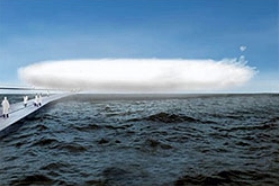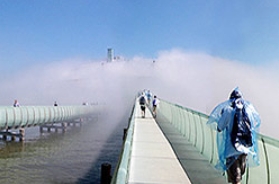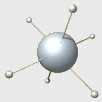|   The Blur Building by Diller + Scofido whirling above Lake Neuchatel , Switzerland.
The Blur Building by Diller + Scofido whirling above Lake Neuchatel , Switzerland.
Computers regulate the spray of tiny drops of lake water from 31400 jets according to climactic changes of humidity, temperature, wind speed and direction. Liquid architecture that synchronizes its form to the environment and the human body.
As visitors enter the Blur Building, they take on a "braincoat". Besides as protection from the misty environment the coat stores personality data for communication with the building's computer network.
Thomas Markussen: A few years ago, architects were almost obsessed with the question of how cyberspace and virtual reality are changing basic ideas about architectural space. But events like the Neuroaesthetics conference here in London , along with the increasing impact of neuroscience on contemporary architectural theory, marks a clear change of interests -- if not a paradigm shift. Significantly, the then almost ubiquitous word "virtual" is now being replaced by "neuro." What is happening?
Brian Massumi: The introduction of digital techniques into architecture, and the preoccupation with the virtual that came with it, brought up some very old questions with a new intensity. The change came at a time when the idea of "virtual reality" was very current in popular culture and had a major presence in the mass media. "Virtual reality" was used as a synonym for "artificial reality." There was something of an apocalyptic tone to many commentaries, to the effect that the new generation of digital technology was creating a technological cocoon around human beings that would separate them from any direct access to the world, and would denature human relations.
The old questions that took on new urgency had to do with the relation between nature and culture. Digital techniques in architecture added a new twist that changed the terms in which this question could be asked. This is because the software put into use by innovative architects such as Greg Lynn was evolutionary rather than representational. Rather than using traditional CAD software, where basic geo m etrical forms are reproduced and then modified or rearranged, architects employed special effects software where you start by programming a set of modifications before you have an object to modify -- a potential modification. That could be a definition of a force. So you begin by programm ing forces rather than forms. You can program a virtual environment with certain forces, for example basins of attraction analogous to gravity. Then you can program virtual objects with their own forces that enable them to resist or deform in certain ways in the presence of the environmental forces. When you run the progra m , the objects are transformed, and sometimes fuse together or split to create odd geometries. But because of the complexity of the system, you can't predict exactly what the outcome will be. The form emerges from the interaction.
Architects are no longer just representing for m s taken from a pre-existing repertory as in postmodernist architecture. They're setting things up so that new forms evolve. This e m ergence of a new form is an event. It's a real event. Something has happened. If something has really happened, then how can you say it's simply artificial? Now, when you say "virtual reality" the emphasis is on the "reality." The old distinction between what is natural versus cultural or artificial falls apart, as form becomes active -- formation.
TM: So, using special effects software as a design tool not only m eans rethinking virtual reality as an ontological category, it is also taking architecture closer to the inner workings of the brain?
BM: I think that the interest today in the "neuro" is related to this shift. We have a tendency to understand our own bodies and brains in relation to the model of our machines. For the Futurists at the beginning of the 20th century, it was the classical thermodynamic m achines that were then transforming the landscape, in particular the train and the automobile. In the latter half of the 20th century, cybernetic machines became the model, and human thought and perception were understood in terms of information processing.
Today, digital design suggests a different model. What if thought and perception were evolutionary events taking place in a complex interactive system? What would that syste m be, if not the brain? What "environmental" forces for the emergence of new form might we find if we take a new look at the physiology of the brain? What would that new understanding of the brain mean for our ideas about art and aesthetic form -- no longer the opposite of nature and matter, but not reducible to them either, at least in the ways we used to understand them?
TM: With regard to this model that you outline here, neurobiology and neuroscience serve as an obvious theoretical reservoir for architects to pick up new ideas about the dynamics and plasticity of form . But what is it that neuroscience can bring into architecture?
BM: I have to admit that I have reservations about neuroscience's appeal. On the positive side, neuroscience is useful for helping us cure ourselves of old habits of thought, like the idea that the brain passively takes in impressions and makes images. There is nothing linear about the functioning of the brain. It does not simply transmit impressions. It coordinates events -- neuronal firings -- that interact in complex ways struck by the same kind of indeterminacy I was just talking about. These events are triggered by changes in the environment, and what comes out of their interaction are movements of our body in the environment, oriented to the changes. Change is the fundamental force of experience. So instead of being a machine for transmitting images, the brain is a machine for translating, or transducing, the force of change into oriented movement. The pattern of the movement is an evolving, emergent form of being. Or rather, of becoming -- because the "shape" of our lives changes as a result. The brain itself also changes. It has a "plasticity," which means that its network of neural connections is itself always evolving.
If you put all this into an architectural context, you get a vision of architecture as constructing the environment that triggers the changes that issue new forms of experience. As architects integrate new technologies more fully into their buildings, what they are really designing are possibilities of experience. They are not just building for practical function. They are becoming experience engineers.
TM: And your reservations?
BM: My reservation is that you don't really need to talk about the workings of the brain to address these issues. You can stick to the level of perception. You can experiment with perceptual effects without necessarily talking about the neural correlates of what happens. There is no reason why art and architecture have to detour through a mapping of neuronal events instead of experimenting directly with perceptual effects. We shouldn't think that we can learn more about experience by looking at the neurons than we could learn by walking around a building, experiencing an interactive art installation, or looking at a screen or a painting.
TM: Digital architecture does in fact strongly appeal to the senses and the body in a new and radical way. What is it about the use of digital technology in architecture that so effectively engages our perceptual system and body?
BM: This is the question that concerns me most. As I said, integrating digital technology into architecture multiplies the possibilities for addressing and transforming perception. The question is related to the use of computer-assisted methods in design, but is not unique to it. It is quite possible for a building designed by using cutting-edge digital techniques to end up addressing perception in entirely traditional ways. It happens all the time.
The active emergence of form does not automatically carry over from the design process into the life of the building once it is constructed. How to m ake the carry-over is precisely the problem . How can a built form build form ? How can a given form function as a form-giver? Only by continuing the process of form emergence on a different level, in the register of the embodied experience of the people who use the building. In other words, by building into the architecture forces of perception that interact in ways designed to trigger experiential events.
A recent example of this kind is Diller + Scofidio's famous " Blur Building " exhibited at the Swiss Expo 2002. The design frustrated the usual visual expectations of architectural style by presenting, at first approach, nothing identifiable, a literal blur created by mist. Rather than addressing vision first and using vision to guide movement as is usually the case, the " Blur Building " frustrated vision in order to address movement first. The building was built to be vague, and then to become determinate through a process of cross- modal interaction that made a perceptual event of visiting it.
Integrating digital technology is not a necessary condition for architecture to address embodied perception in order to trigger experience events. But it can of course be a very powerful tool for this, because it allows cross-connections that were never before possible. This m akes it possible to transduce changes occurring on one level of experience into events on a different level with infinitely increased flexibility, even at a distance.
TM: What you just said makes me think of the Dutch architect Lars Spuybroek. At a time when cyberspace still represents a disembodied realm of floating identities to a lot of people, Spuybroek actually uses digital technology to mix up distant cyberspace with the most intimate part of body space. That way he explores new experiential forms in architecture, new identities.
BM: Lars Spuybroek and his NOX Studio are a m ong the pioneers in this. Spuybroek has been centrally concerned with the connection between movement and vision as well, but has also explored possibilities of cross-connecting perceptual changes with m odulations of emotion. An example is Q.S. Serafijn's Spuybroek's D-tower [1] project in Doetinche m in the Netherlands . The tower is a sculpture in the town center that is hooked up to a website. Town residents complete on-line questionnaires about their mood. The tower changes color according to the results, becoming a beacon of the collective mood. Affect has been given visual expression. The predominant affective quality of people's interactions becomes visible. This can undoubtedly reflect back on the interactions taking place in the town by making something that was private and imperceptible public and perceptible. A kind of feedback loop has been created between private mood and public image that has never existed in quite this way before.
There are any number of ways for creating this kind of eventful cross-connection, between different perceptual modes, different phases of perception formation, and between perception and affect. What has been accomplished thus far is just the tip of the iceberg. It is crucial to note that -- to the extent that these connections are made -- the digital technologies that may be used are not functioning primarily to transmit information. What they are doing, through the trans m ission of information, is triggering real, lived events that involve a qualitative transformation. Information delivery is the least interesting thing they do. It is only interesting to the extent that it fee ds the creative emergence of new forms of lived experience.
TM: Your ideas, writings and philosophical translations have provided architects with key concepts to understand the hyperaesthetics of digital architecture. What are you currently working on?
BM: I a m currently working on two books. One, entitled Architectures of the Unforeseen , is dedicated to just these questions of design, perception, and emergent forms of experience in architecture and interactive art. A second project, Empire of Emotion, is about the presidency of George W. Bush, 9/11 and the Iraq War. Although it may seem far afield, the two projects are actually closely related. The Bush project tries to understand the way in which political power is becoming more and more image-based in a way that exploits some of the same connections between modes of perception and dimensions of experience, in particular vision, movement, and affect. It is an attempt to study the specifically perceptual logic of present-day power.
References
Q.S. Serafijn, Nox, D-tower , http://lab.v2.nl/projects/dtower.html ; http://www.d-toren.nl/site/ |

